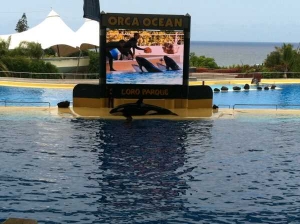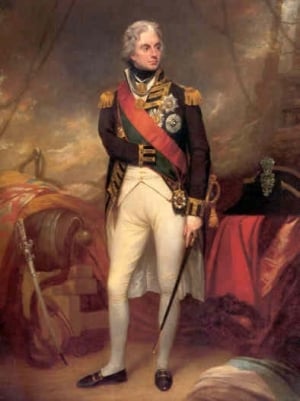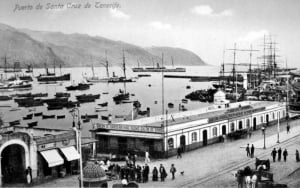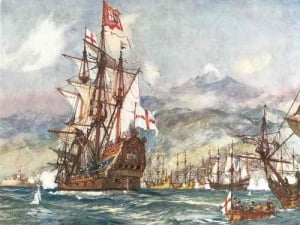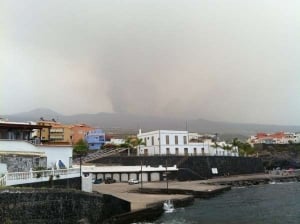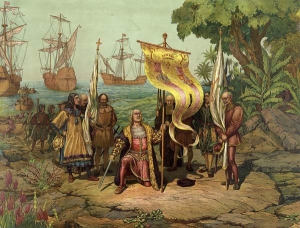
This article was by written Peter Allan
Peter fist visited Tenerife in 1982 staying in Puerto de la Cruz, and is now a habitual visitor to the island having become fascinated by its diversity, spending in excess of 8 weeks a year there. He has travelled all around the island staying in the lesser known resorts and towns, and has a particular interest in the history of Tenerife.
Computer Failure Causing Flight Delays to Tenerife Today
A computer failure this morning at Swanwick control centre near Southampton has resulted in flight delays to Tenerife today. The problem restricted the number of flights crossing the south of the UK and aircraft taking off from airports.
Check the live Tenerife Airport Arrivals Board
The problem was fixed by a reboot of the air traffic computer system that had caused a rouge flight plan. A spokesperson for Gatwick airport said that flights from Europe could be affected by restrictions on flights around Jersey’s airspace.
Flights are returning to normal but there may still be some delays as is apparent from the live Tenerife airport arrivals board.
Read more about this
Baby Orca Dies at Loro Parque
An Orca born at Loro Parque in Tenerife on the 3rd August last year has died. Loro Parque issued a statement on their Facebook page last month announcing the sad death of the 10 month old killer whale, Vicky.
She had been behaving strangely for a few days before her death and a specialist vet had been sent over from the USA.
The death of Vicky has highlighted concerns about the breading in captivity of killer whales. There are concerns about the inbreeding and the fact that Vicky’s mother had been removed from her own mother at an early age. She rejected Vicky almost immediately so the young calf was being hand reared by the staff at Loro Parque.
easyJet Adds New Winter Routes to Tenerife
Low cost airline easyJet have announced new routes for the winter 2013 schedule, including a twice weekly winter sun flights to Tenerife from Newcastle starting 6th November, with flight fares starting at £28.49.
Live Tenerife Airport Arrivals Board
Other new routes are London Gatwick to Bucharest, Liverpool to Larnica, London Luton to Venice and Manchester to Lyon increasing the airlines capacity by 190,000 seats.
Live Tenerife South Airport Departures Board
The airline carried 34 million passengers in the last 12 months from 11 bases in the UK.
Read More
Ryanair Flying Out of Bournemouth for the Winter Sun Season 2013
Ryanair, the low cost carrier, will be operating out of Bournemouth airport for the 2013 winter sun holiday season. In 2010 Ryanair stopped flying out of Bournemouth for the winter due to, it says, air passenger tax duty.
This year though, it will be flying six routes to winter sun destinations including Tenerife, operating nine weekly flights, with a capacity of 3500 seats in and out of Bournemouth.
Live Tenerife Airport Arrivals Board
This year the airline resumed flights out of the airport in March, which is later than previous years when they started operating in February, blaming oil prices for the later than usual start.
Live Tenerife South Airport Departures Board
Lesley Kane, head of marketing for Ryanair, said the airline could not give any long term commitment to flying from Bournemouth airport during the winter months.
Admiral Nelson Letters Sold for £54,500 at Auction
A letter written by Admiral Lord Nelson in 1804 has been sold at auction for £54,500 by Hansons Auctioneers in Derbyshire. The letter was written by Nelson in his left hand, seven years after losing his right arm at the Battle of Santa Cruz de Tenerife in July 1797 on the island of Tenerife in the Canary Islands.
This letter, dated 21st October 1804 and described as a ‘scrawled piece’ by the auctioneers, was written a year before lord nelson’s death off the Spanish coast near Cádiz, at the Battle of Trafalgar in 1805. It was written to praise Major James Weir of the Royal Marines.
Nelson wrote of Major Weir: ‘You merit everything which a grateful country could bestow upon your services. I shall be soon in England and if my testimony of your services can be useful it shall be very much at your service.’
Another letter written before he lost his arm dated 7th may 1793 sold for £11,000.
The letters were expected to fetch about £20,000 combined.
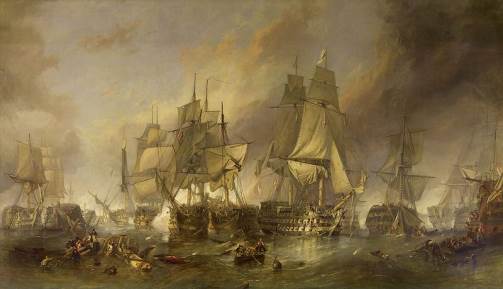 The Battle of Trafalgar by William Clarkson Stanfield
The Battle of Trafalgar by William Clarkson Stanfield
Miss World Spain Held in Tenerife
The contest was held in the Lago Martiánez pool complex in the seaside resort of Puerto de la Cruz Tenerife in the Canary Islands, on Saturday.
Miss Ibarbia is committed with social assistance and and spent several months helping elderly people ‘helping people that society sometimes forgets’.
Emigration from Tenerife
Ever since the Spanish conquest of Tenerife there have been extensive periods of emigration from the island, usually coinciding with economic downturns. Ships have always used the Canaries as a stopover on voyages between Europe and the Americas, making it easy to book a one way passage.
The most popular destination was Latin America where Spanish is widely spoken. Cuba was one of the earliest destinations of the Canarian emigrants, where they played an important part in the development of the capital city Havana, and of the famous cigar making industry.
In the eighteenth century several families left Tenerife and ended up founding the city of Montevideo in Uruguay, and the towns of San Antonio in Texas and San Bernado, Louisiana, USA.
When the Spanish civil war broke out in 1936, there was renewed emigration due to poor living conditions and the fear of reprisals, but this time the destination was mainly Venezuela due to its promising economic outlook.
The outbreak of WW2 led to the collapse of Tenerife’s economy as access to foreign markets was denied, and many thousands left the island in search of a better life. These included politicians, intellectuals, scientists, writers and artists, who were being persecuted by the Franco military regime, and went into voluntary exile. Many of them set up organisations in their adopted countries to fight for freedom and the restoration of democracy to Spain.
This migration continued up to the 1970’s, but had stopped almost completely by the mid 1980’s due to rampant economic development caused by the new booming tourist industry.
These days, with the continued growth of tourism and the prosperity this brings, there is a reversal of this migration, with many of the migrants and their descendants returning to the Tenerife, especially from Venezuela. There has also been a large immigration of people from northern Europe seeking to escape the cold weather and live in a warm sunny climate.
Battle of Santa Cruz de Tenerife 1657
In April 1657, The Royal Navy, under the command of General at Sea Robert Blake, won a devastating victory over the Spanish at Santa Cruz de Tenerife in the Canary Islands during the Anglo Spanish War of 1654-1660. This defeat for the Spanish, the biggest since the loss of the armada in 1588, left the countries finances in ruins and forced her to abandon plans to invade Portugal.
The British had been at war with the Spanish since 1654, and Oliver Cromwell as Lord Protector had plans to capture the Spanish colonies in the West Indies. Part of this plan involved the capture of the Spanish silver bullion Treasure Fleet that sailed across the Atlantic every year between Spain and the Americas.
The capture of this fleet would cripple Spain financially ending its war effort, and at the same time boost the finances of the Commonwealth of England.
Blake set sail with his fleet of 46 ships in the spring of 1656, heading for the Spanish coast, but much to his frustration the Spanish refuse to do battle. He responded by sailing to the port of Cadiz in southern Spain, where the British blockaded the port for the winter of 1656-57 with the intention of intercepting the Spanish bullion treasure fleet.
The Spanish bullion fleet realised they could not enter the port of Cadiz because of the blockade, so the fleet was ordered to sail to the port of Santa Cruz de Tenerife in the Canary Islands, with the intention of completing the voyage under escort when it was safe to do so.
Blake received intelligence the bullion fleet was waiting in Tenerife and set sail immediately, arriving off the coast of the island on 18th April. After deliberating with his captains, it was decided they would attack the Spanish flotilla anchored inshore with 12 of their ships, with the remainder waiting further out to sea.
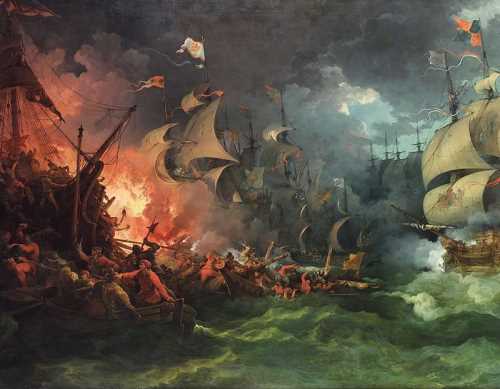 Spanish Armada
Spanish Armada
The British ships faced a formidable task; the port of Santa Cruz was heavily defended by gun batteries on shore, and the Spanish war ships were formed in line to be able to fire broadsides at the British as they approached. They nethertheless managed to enter the harbour and get between the lines of Spanish ships, destroying or capturing all the Spanish ships.
The Spanish had made a serious error by placing their inner line of ships between the batteries and the English. Five Spanish ships were taken as prizes and were taken under tow out of the harbour but it was extremely difficult to get them out to sea, and the unpopular decision was made to set them on fire and abandon them, with the loss of prize money for their capture for the crews.
The English ships all escaped with only one suffering heavy damage, but the major disappointment was the failure to capture the silver bullion, which the Spanish had moved ashore and hidden.
Blake was hailed a national hero in England, but died on the homeward journey when his ship was within sight of Plymouth, and was buried in Westminster Abbey with a full state funeral.
The Spanish now had no means of transporting the silver bullion from Tenerife to Spain, and the lack of finance fatally undermined her position in Portugal and Flanders. The victory also established England as a major sea power.
Fire Fighting Seaplane to be Stationed on Tenerife
This part of the government’s plans to combat forest fires this summer which has allocated 65 aircraft, fewer than last year at 70. There will be 32 planes and 31 helicopters placed at strategic places throughout Spain.
There will also be 10 fire brigades on standby specialising in large forest fires.
Last year there were several large forest fires on Tenerife the worst situated in the mountains above the southern tourist resorts. Several villages were evacuated, but there was no risk the tourist areas.
Garajonay National Park was devastated by fire last summer, some being started deliberately, destroying priceless forest surviving from the Tertiary period.
Christopher Columbus
Christopher Columbus, the Italian explorer and discoverer of the New World, had many connections with the Canary Islands.
In August 1492, Columbus set sail from southern Spain to find a western route to the Indies, and also to prove the world was round, as many Catholic Theologians at the time were still insisting it was flat. Most educated Europeans however, had realised the world was in fact round since Aristotle’s work in the 4th century.
He first sailed to the Canary Islands, stopping at San Sebastian on La Gomera for provisions before setting out on the five week voyage across the Atlantic, where he discovered the Americas.
Columbus also came here to visit Beatriz de Bobadilla, who had been a mistress of king Ferdinand of Spain, with whom he had a romance and stopped here on his first three transatlantic voyages.
By the time of his fourth voyage Beatriz had married one of the islands most powerful men, so he wisely gave La Gomera a miss.
Columbus reportedly witnessed the volcano Mount Teide erupting on the island of Tenerife on his first voyage across the Atlantic in 1492, where he saw "a great fire in the Orotava Valley". It is apparent from carbon dating there was no eruption that year in the Orotava Valley, but there was from the Boca Cangrejo vent on the Santiago rift.


